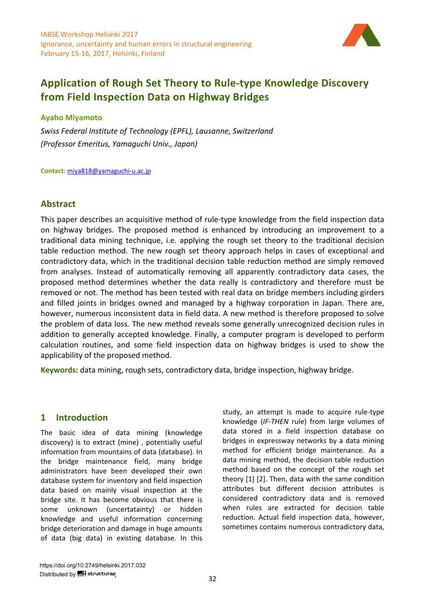Application of Rough Set Theory to Rule‐type Knowledge Discovery from Field Inspection Data on Highway Bridges

|
|
|||||||||||
Détails bibliographiques
| Auteur(s): |
Ayaho Miyamoto
(Swiss Federal Institute of Technology (EPFL), Lausanne, Switzerland (Professor Emeritus, Yamaguchi Univ., Japan))
|
||||
|---|---|---|---|---|---|
| Médium: | papier de conférence | ||||
| Langue(s): | anglais | ||||
| Conférence: | IABSE Workshop: Ignorance, Uncertainty, and Human Errors in Structural Engineering, Helsinki, Finland, 15-16 February 2017 | ||||
| Publié dans: | IABSE Workshop Helsinki 2017 | ||||
|
|||||
| Page(s): | 32-42 | ||||
| Nombre total de pages (du PDF): | 11 | ||||
| DOI: | 10.2749/helsinki.2017.032 | ||||
| Abstrait: |
This paper describes an acquisitive method of rule‐type knowledge from the field inspection data on highway bridges. The proposed method is enhanced by introducing an improvement to a traditional data mining technique, i.e. applying the rough set theory to the traditional decision table reduction method. The new rough set theory approach helps in cases of exceptional and contradictory data, which in the traditional decision table reduction method are simply removed from analyses. Instead of automatically removing all apparently contradictory data cases, the proposed method determines whether the data really is contradictory and therefore must be removed or not. The method has been tested with real data on bridge members including girders and filled joints in bridges owned and managed by a highway corporation in Japan. There are, however, numerous inconsistent data in field data. A new method is therefore proposed to solve the problem of data loss. The new method reveals some generally unrecognized decision rules in addition to generally accepted knowledge. Finally, a computer program is developed to perform calculation routines, and some field inspection data on highway bridges is used to show the applicability of the proposed method. |
||||
| Mots-clé: |
pont-route
|
||||
